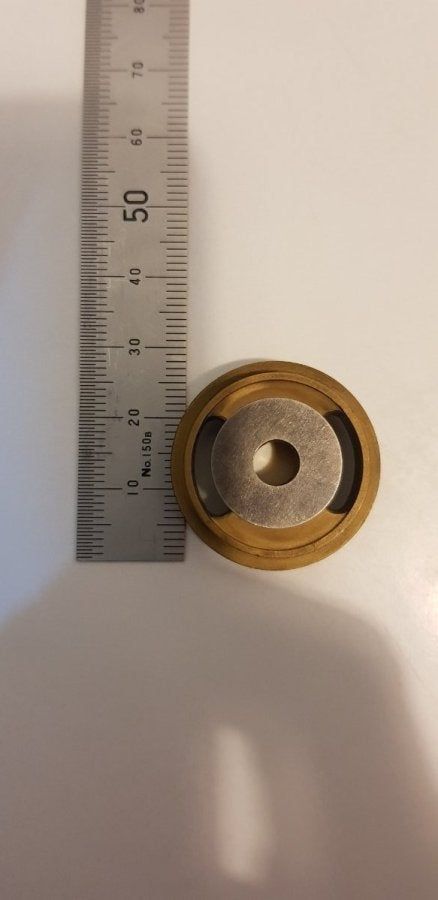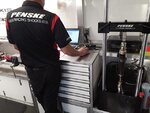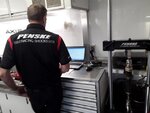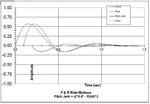I was pointed here from mustang6g.
I am finally getting away from AutoX. It is fun but I want to participate in dedicated track days now. I am coming from a 997tt that I ran a custom valved coilover setup among other suspension mods. I have a factory 2017 gt350 and I will be fitting custom valved dampers and 450/750 springs.
Lurking here it looks as if there is more technical information so I will chronical my project here as well. I have also sourced a shock dyno and may soon begin testing shim stack configurations for myself. I will also be getting the rear control arms form cortex racing in order to fit traditional round end mounted dampers.
For my setup I have calculated:
66lbs/in = critical damping for the front
72lbs/in = critical damping for the rear
With 450lbs springs front and 750lbs springs rear, that yields a 2.0hz front frequency and a 2.2hz rear frequency. Based on milliken, milliken RCVD 1.5-2.5hz is the threshold, or break point range for subjectively "stiff" setups.
I will be running a 62% LS damping rate and a 25% HS rate in the front
&
a 54% LS rate with a 22% HS rate in the rear
Because I will have a two way shock I figured a forced match shock would be best as I could have bump and rebound on their own bleed circuits and I could dial in the correct asymmetry if needed. I have run force matched bump: rebound on my 997 and it was great. I think though after additional experience I think the lower damping rate and lower gas pressure helped the soften the feel quite a lot and that, maybe there is some use for the rebound bias on a road car. I plan to data log the OEM setup and then my new custom setup at COTA. I will be logging lap times with force matched settings, rebound biased and bump biased configurations. Is there any interest in this sort of thing here? I am out to quantify data for setups and to objectively prove what works and what doesn't. I know the 350 has terminal understeer, and I may see what ways there are to combat this in the future, although it may ultimately be a OE chassis / linkage limitation. If interested I can post my collection of links for shock data, shock tuning theory, as well as other sources which have inspired this project from me.
I am finally getting away from AutoX. It is fun but I want to participate in dedicated track days now. I am coming from a 997tt that I ran a custom valved coilover setup among other suspension mods. I have a factory 2017 gt350 and I will be fitting custom valved dampers and 450/750 springs.
Lurking here it looks as if there is more technical information so I will chronical my project here as well. I have also sourced a shock dyno and may soon begin testing shim stack configurations for myself. I will also be getting the rear control arms form cortex racing in order to fit traditional round end mounted dampers.
For my setup I have calculated:
66lbs/in = critical damping for the front
72lbs/in = critical damping for the rear
With 450lbs springs front and 750lbs springs rear, that yields a 2.0hz front frequency and a 2.2hz rear frequency. Based on milliken, milliken RCVD 1.5-2.5hz is the threshold, or break point range for subjectively "stiff" setups.
I will be running a 62% LS damping rate and a 25% HS rate in the front
&
a 54% LS rate with a 22% HS rate in the rear
Because I will have a two way shock I figured a forced match shock would be best as I could have bump and rebound on their own bleed circuits and I could dial in the correct asymmetry if needed. I have run force matched bump: rebound on my 997 and it was great. I think though after additional experience I think the lower damping rate and lower gas pressure helped the soften the feel quite a lot and that, maybe there is some use for the rebound bias on a road car. I plan to data log the OEM setup and then my new custom setup at COTA. I will be logging lap times with force matched settings, rebound biased and bump biased configurations. Is there any interest in this sort of thing here? I am out to quantify data for setups and to objectively prove what works and what doesn't. I know the 350 has terminal understeer, and I may see what ways there are to combat this in the future, although it may ultimately be a OE chassis / linkage limitation. If interested I can post my collection of links for shock data, shock tuning theory, as well as other sources which have inspired this project from me.



















